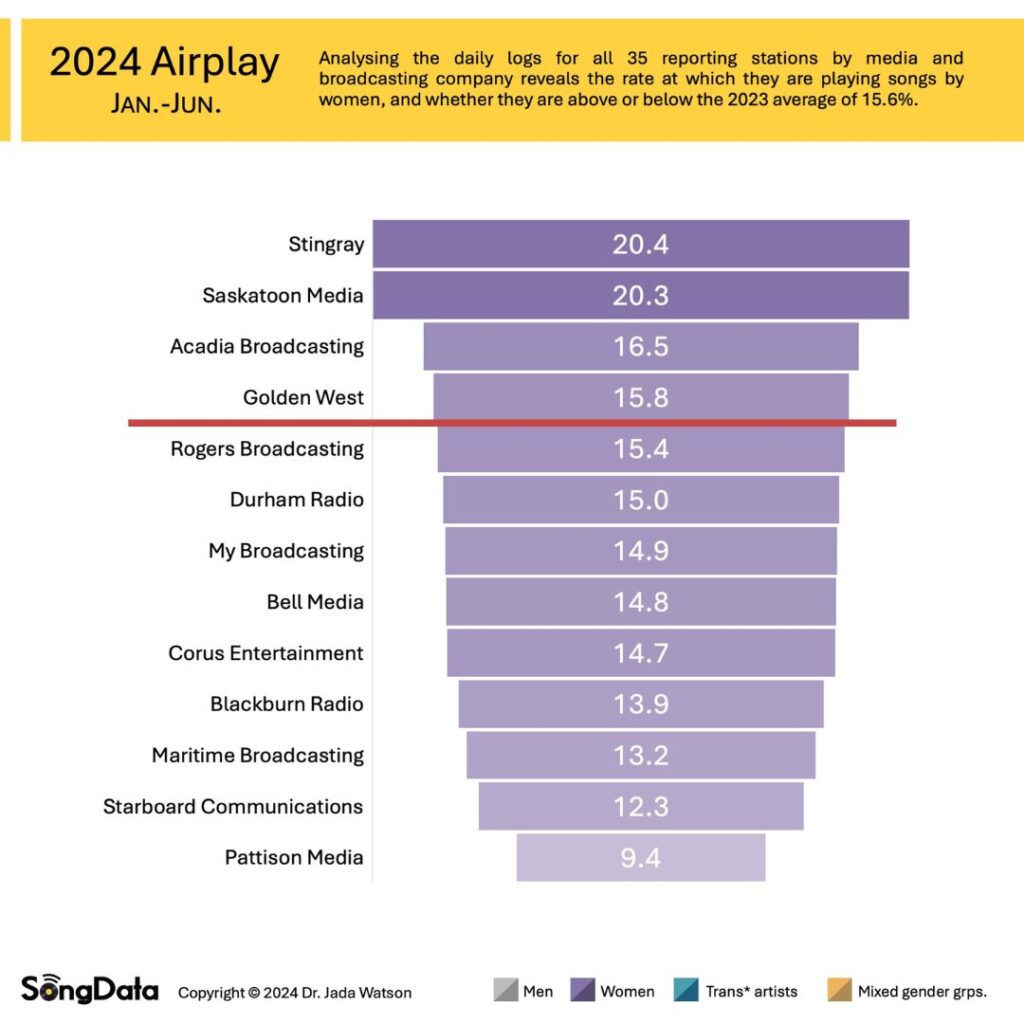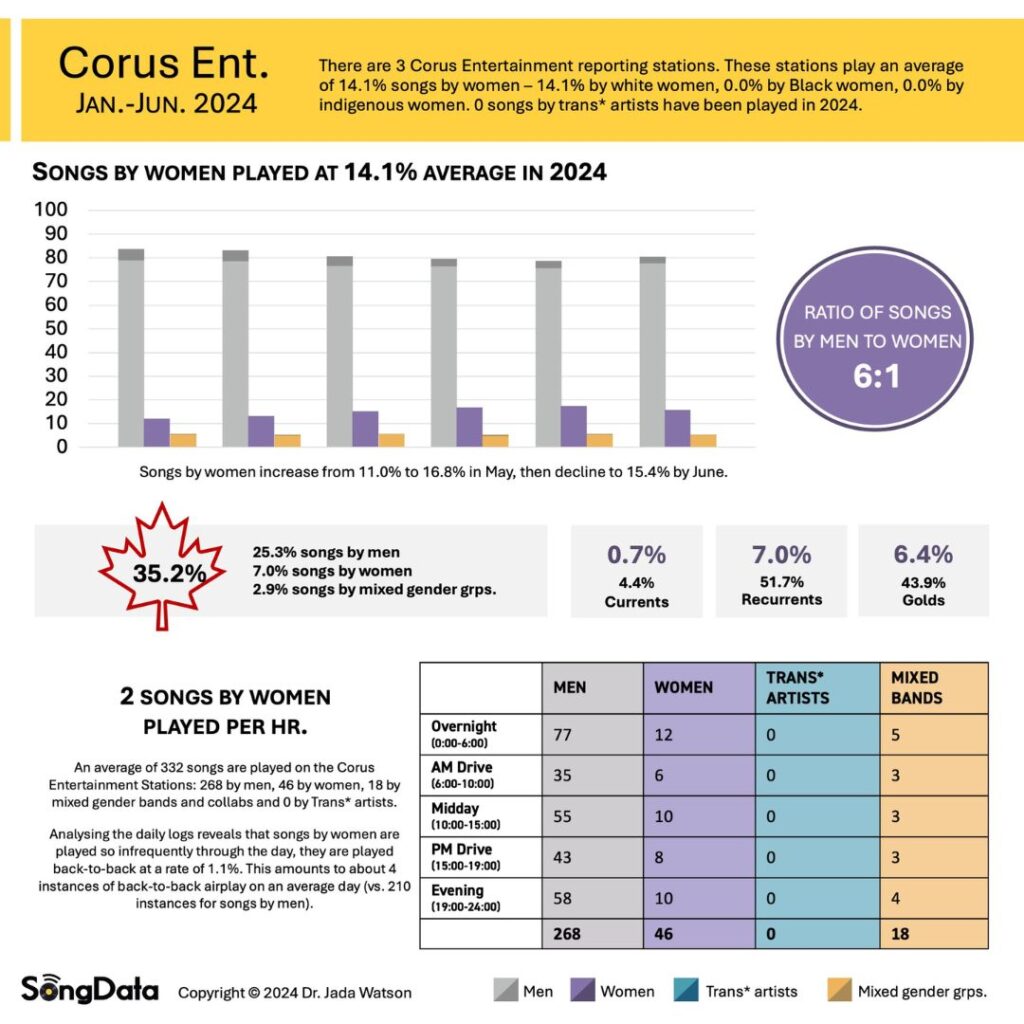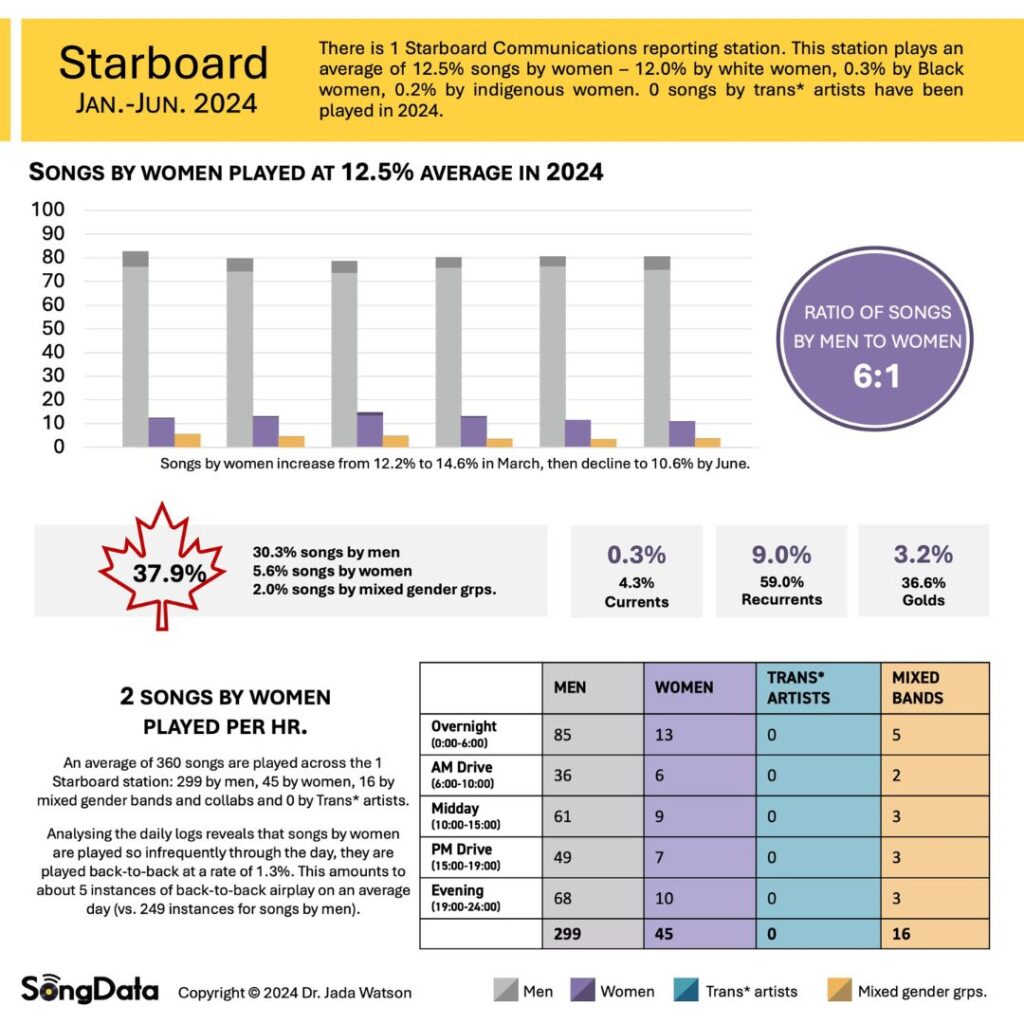The Canadian country music industry descends on Edmonton, Alberta this week for its annual Country Music Week. Hosted by the Canadian Country Music Association, Country Music Week serves as both a celebration of the industry’s achievements and an event to promote and create opportunities for artist exposure.
It’s also a moment for the industry to come together to talk about business practice – discuss challenges and opportunities, trends and changes in technology, and to think about the year ahead.
An ongoing topic of discussion within the country industry (in Canada and around the world) is the historic underrepresentation of women – especially women of colour – and the absence of Trans* artists on radio. In June 2024, Dr. Jada Watson released via SongData “Share the Air”, a study of gender representation on Canadian radio in partnership with Women in Music Canada and the National Arts Centre that revealed songs by women were consistently underprogrammed on the format – at an annual average of just 15.0% in 2023.
Dr. Jada Watson joined us for a special bonus episode of our podcast
How are things going in 2024? SongData teamed up with Front Porch Music to share an update on representation in programming for the first 6 months of 2024 – with a twist! This time, Jada analysed the daily logs for each of the 35 reporting stations from 1 January 2024 to 30 June 2024 – just over 2.3 million rows of data! A full deck of graphics can be downloaded here.
****
Things Ain’t Right Round Here.
On this week’s Mediabase country radio airplay chart, just 3 songs by women appear within the Top 20 most played songs:
- Lainey Wilson’s “Hang Tight Honey” (#6),
- Dasha’s “Austin” (#12), and
- Sacha’s “Hey Mom I Made It” (#14).
If we consider the full 50-position chart, two more songs by women join the list – MacKenzie Porter’s “Have Your Beer” (#30) and Savannah Jade’s “He’s the One” (#49) – totalling 10% of the airplay charts in Canada.
That number increases to 7 (14%) if we include collaborations by Ella Langley (with Riley Green) on “you look like you love me” and Kelsea Ballerini (with Noah Kahan) with “Cowboys Cry Too”.
Things ain’t right round here, folks. This low representation of songs by women on the charts may not be new, but it’s down from 2023 chart numbers and is part of a broader downward turn in programming that has unfolded on the format in the USA and here in Canada. It’s also coming at a time when country music is “cool again” and songs are crossing into the mainstream in unprecedented ways … if you’re a white male artist, that is.
In a study I published in partnership with Women in Music Canada and the National Arts Centre three months ago, we found that songs by women were programmed at an average of 12.8% within the top 150 played each year between 2013 and 2023.
RELATED: Women In Country Spotlight: A Snapshot of “Share the Air” Research Study and Country Music …
Last year? Songs by women were played at a solid average of 15.6% across the 35-reporting stations in Canada – and most of that airplay (15.2%) was for songs by white women. Women of colour were invisibilised within radio programming, their songs spun just 0.4%. Trans* artists were completely absent on the format, with just 5 spins over the calendar year (0.00009%).

While we’re only 3 months out from Share the Air, I thought it was time for a check-in on programming and wanted to try something new this time. Instead of using the weekly published reports of aggregated data from the 35 reporting stations, I wanted to work with station-level data. I pulled the daily logs for each station for the 182 days in the first 26 weeks of 2024 (1 January to 30 June) – logs that contain the daily reporting of songs played over the 24-hour programming period and includes designation for CanCon certification and current, recurrent, and gold status. This totaled 2.3 million rows of data covering the first 6 months of the year. I then augmented those daily logs according to my SongData methodology (the same approach used for the Share the Air report), with the coding capturing ensemble type, gender identity and race and ethnicity for the artists to allow for analysis of airplay for the first 6 months of 2024. (Read the Methodology for Share the Air here.)
How does it look? Let’s dive in!
Representation on Canadian Radio in 2024
At the end of 2023, songs by women were being programmed at 15.0% – an average that had held consistently throughout the year. This year began with country radio programming songs by women at a slightly lower rate of 14.1%, but this increased through March to a peak of 17.4% – higher than the annual average in 2023. But this did not last long and in the months that followed, songs by women were on the decline again, dropping to 14.4% by June. Looking at the 6-month average of 15.4% shows us that most of this airplay was for songs by white women (14.8%), with just 0.3% for songs by Black women and 0.3% for songs by Indigenous women.
Almost all of the airplay for songs by women of colour went to just 3 songs: Teigen Gayse’s “Sleeping With Her” was played through January and February, Beyoncé’s “Texas Hold ‘Em” entered programming in February until it declined from playlists in May, when it was replaced by Sacha’s “Hey Mom I Made It”. Outside of these three tunes, songs by Black, Indigenous, and women of colour barely registered on station logs, with just 0.07% of the overall airplay. Despite an important panel discussion at the 2023 Canadian Music Week hosted by MJ and increased conversation around the systemic racism of this industry, the format in Canada (and in the USA) is showing little signs of interest in change. (Side note: you can now listen to the Uncharted Country panel online!)
One element of programming that we lose when we look at weekly reports is the presence of specialty programming because of how aggregation flattens programming activity. With daily logs, though, we can see spikes in airplay that correspond to celebrations. Looking at the daily logs of the first 6 months of 2024, we see a 30% spike in spins for songs by women on 8 March 2024: International Women’s Day…
Both Stingray and Acadia stations played songs by women at 48.0% of their programming (a 118.8% and 124.4% boost in spins for songs by women, respectively). Except for Maritime and Starboard stations, which actually registered a drop in airplay for songs by women on IWD, all other stations programmed songs by women at an increase, too: 57.6% at Rogers, 24.9% at Pattison, 21.4% at Bell, 14.4% at My Broadcasting, 11.5% at Saskatoon Media, and 10.9% at Blackburn.
While programming for a celebration of women’s achievements is important, to be sure, the results here show us just how little impact specialty programming has on representation within the format. What’s the point of a celebratory “boost” if you’re just going to return to status quo the next day? Or worse: program songs by women less in the weeks that follow?


click the image to expand >>>
We can also see through daily logs a snapshot of programming at the station level to see where, within the national average of 15.4%, stations are falling on representation. Stingray and Saskatoon Media stations program songs by women at the highest representation in the country – at just over 20.0% of their daily logs, while Pattison Media comes out at the bottom with 9.4% of their programming for songs by women. All other stations fall between 12.3% and 16.5% – hovering around the 15.0% average.
Scroll through each media/broadcasting company’s programming for the first 6 months of 2024 to see the monthly average, ratio of songs by men to women, CanCon distribution, dayparts and more!














click the image to expand >>>
With most stations still playing about 2 songs by women per hour, the daily logs allow us to take analysis one step further to see how likely it is that any of those songs by women are played back-to-back. And, unsurprisingly, the rates are pretty low on most stations with less than 10 instances of back-to-back rotation on almost all stations and 1 instance of back-to-back rotation on Pattison stations (and that’s… on days where a back-to-back rotation even occurred on Pattison stations). Songs by men, prioritised within programming, are played back-to-back-to-back-to-back-to-back-[etc. …] more than 200 times a day!
The low rate of play and continued practice of spreading out songs by women so they are rarely heard at all or in proximity harms us all.
First, it limits the potential for songs by women on charts and opportunities within the industry. Festival and tour bookers look to radio and charts to make their own programmatic decisions, and a quick scan of festival lineups reveals that women are not just underrepresented in our ears but on concert stages.
Radio and chart data is likewise used as criteria for award eligibility, and the decrease in airplay for songs by women tells us that the pool of eligible songs by women is shrinking by the day. So far in 2024, songs by women have averaged 20.8% of the airplay charts, increasing from 17.5% in January to a peak of 24.0% in March and back down to 18.4% by June.
And just as with the Share the Air study, songs by women are programmed at such a low rate across the Canadian Country format that they are filtered out of the chart’s top positions. Taking into account representation across the 1,300 possible positions in the 26 weeks considered here, songs by women are programmed at 20.8% of the Top 50 charts, 14.4% of the Top 20, 7.7% of the Top 10, with just 1 song (3.8%) being spun at the top position so far this year – Lainey Wilson’s “Wildflowers and Wild Horses” on March 15, 2024. None of the songs by women that reached the Top 20 in this period were by a woman of colour. Though, it is important to note that Sacha’s “Hey Mom I Made It” currently sits at #14 on the airplay charts and is the first song by a Black woman to reach the Top 20 in Canada!

These programmatic practices also influence the fans. Radio shapes the audience’s experience and understanding of country music culture. The repeated play of songs places the voices and stories of artists in our ears, our minds, and our hearts. Underplayed (and in some instances absent) on Canadian country radio, songs by women, Trans* artists, and artists of colour are heard less frequently — rendering their voices unfamiliar with station listeners.
This type of programming alters the public’s perception of the contributions of these artists to country musical culture. As a result, there is serious danger that listeners will make false assumptions about the place of these artists in the industry; they’ll believe (based on programming) that only a few women, Trans* artists, and artists of colour are interested in creating country music, or that they don’t make music of sufficient quality to be played on their trusted station. This situation is perhaps most critical for Trans* artists and Black, Indigenous, and women of colour whose songs are almost absent from Country radio, leaving listeners to assume that they do not participate in mainstream spaces.
What’s at stake?
Things still ain’t right round here… It’s hard to find something to “celebrate” in the daily logs of the 35 reporting stations. Women are certainly making significant contributions to country music, but radio is definitely doing very little to be part of their journey; most stations continue to be a barrier to exposure and audience building for women – especially Black, Indigenous, and women of colour – in Canada.
As conversations in the industry inevitably turn to celebrating women’s “resilience” in the industry, it’s necessary to acknowledge why they need to be resilient in the first place. Resilience narratives naturalize the barriers and challenges that women face and obscure the role that the industry plays in creating the need for such resilience. It’s programming like this – that holds songs by women to 15% (or less) of programming, that relegates most of the airplay of their songs to the evenings and overnights and spreads out their songs to avoid them being played in proximity. It’s a practice that limits pathways to the charts to just a few women at a time, and above all denies these opportunities to Black, Indigenous, and women of colour.
What’s at stake? Erasure.
As Desiree Dorion stated in an interview we did together on CBC’s Commotion in June 2024. This type of programming, as Desiree reflected, is tantamount to erasure of Black and Indigenous women from the format – erasure of their perspectives, of their views, of their very existence in the artistic format.

Dr. Jada Watson
Jada Watson is an Assistant Professor of Digital Humanities in the School of Information Studies at the University of Ottawa. She is the lead researcher of SongData, a research program that evaluates representation within the North American music industry. In June 2024 she released in partnership with Women in Music Canada and the National Arts Centre: Share the Air: A Study of Gender Representation on Canadian Radio (2013-2023).
- This author does not have any more posts.
In country music, the Front Porch has long been a place of reflection. A place where you can look at the life you have inside that front door. A place where time almost seems to stand still, where you can get away. It’s also a place where you can go to observe the world as it passes by you. To think about your place out there beyond the driveway.
- Front Porchhttps://frontporchmusic.ca/author/admin/
- Front Porchhttps://frontporchmusic.ca/author/admin/
- Front Porchhttps://frontporchmusic.ca/author/admin/
- Front Porchhttps://frontporchmusic.ca/author/admin/











